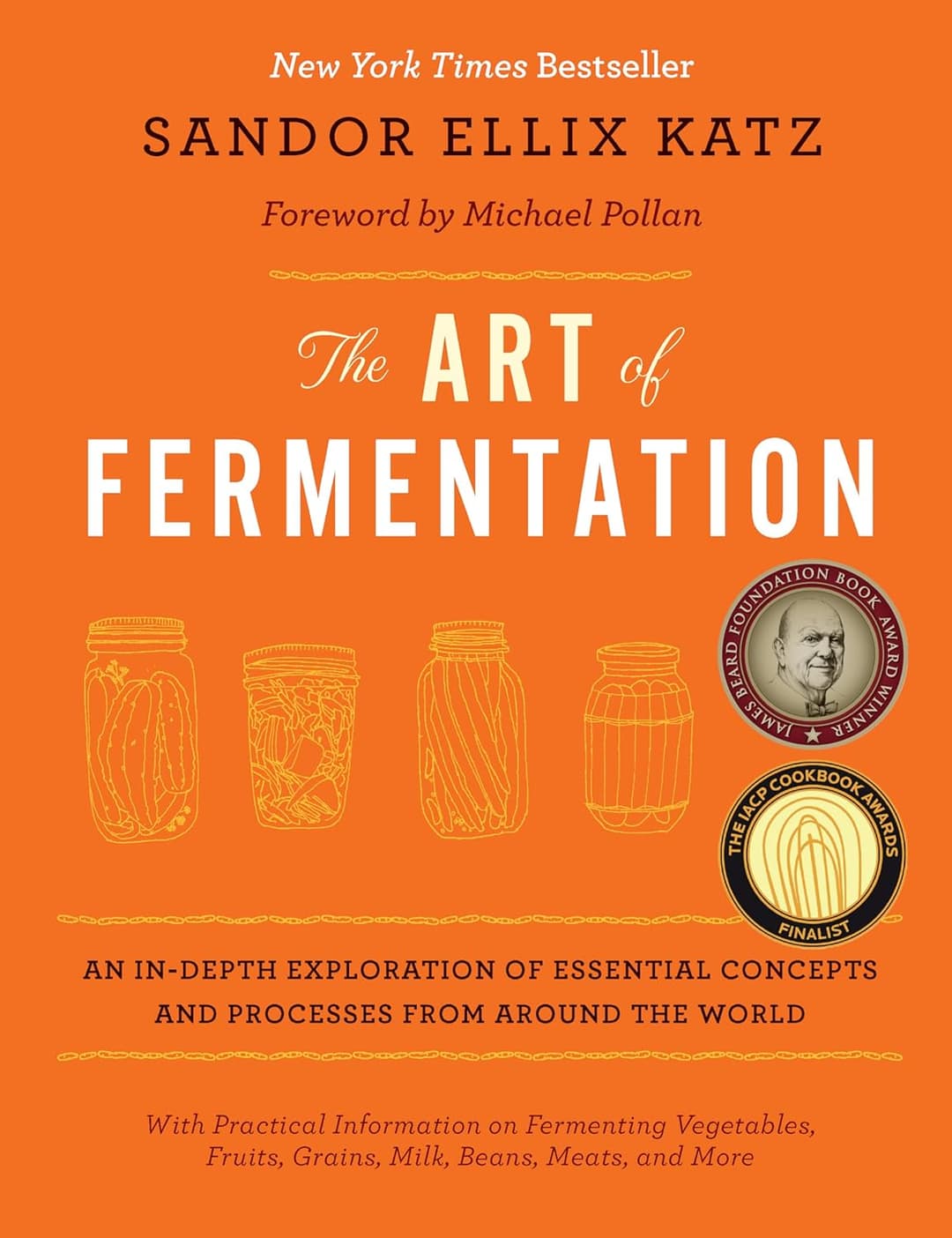
The Art of Fermentation
By: Sandor Ellix Katz
Category: Health
Finished:
Highlights
By some estimates, as much as one-third of all food eaten by human beings worldwide is fermented,' and fermented food production, taken as a whole, constitutes one of the world's largest industries.
Bacteria break down nutrients we would not otherwise be able to digest" and play an important role, just beginning to be recognized, in regulating the balance between energy use and storage." Gut Health
One bacterium formerly ubiquitous in humans, Helicobacter pylori, which resides in the stomach, is now found in fewer than 10 percent of American children and may be headed toward extinction.
Fermentation has been found to reduce naturally occurring Nitrate and Oxalic Acid in Vegetables. It has also been found to biodegrade certain Pesticides residues on vegetables.
Can your Sauerkraut ruin your beer? Can your beer ruin your cheese? Or can your Kombucha contaminate your kefir? My short answer to this question is that while different cultures may subtly influence one another through the air over time, typically this is not an issue.
If you add heavily chlorinated water into mixtures you wish to ferment, you may find that the Chlorine prevents Fermentation altogether, or slows, changes, or inhibits it. If you are working with chlorinated tap water, it is best to remove the chlorine.
You can use filters to remove Chlorine from water. Or you can boil the water in an open pot; the chlorine will evaporate.
I typically work with unrefined Sea Salts. Because one of the important nutritional benefits of fermentation is making minerals bioavailable, I have come to the conclusion that it makes sense to ferment with salts containing a broad spectrum of minerals, rather than sodium chloride alone.
In a nutshell, the steps I typically follow when I ferment vegetables are:
- Chop or grate vegetables.
- Lightly salt the chopped veggies (add more as necessary to taste), and pound or squeeze until moist; alternatively, soak the veggies in a brine solution for a few hours.
- Pack the vegetables into a jar or other vessel, tightly, so that they are forced below the liquid. Add water, if necessary.
- Wait, taste frequently, and enjoy!
Kimchi recipes typically call for pre-soaking vegetables in salty brine (3 to 6 hours in a brine of 15 percent salt by weight, or 12 hours in a 5 to 7 percent salt brine20). Often, vegetables are turned or stirred a few times during their soak. Alternatively, chopped vegetables may be dry-salted, fairly heavily, and left to sweat a few hours, turned, mixed, and agitated; followed by a thorough rinse to remove excess salt. The Kimchee Cookbook, the most comprehensive book on the topic that I have found.
All varieties of hot peppers may be preserved by fermentation. The method is extremely simple, exactly the same as the sauerkraut method. Fermented Hot Peppers #Hot Sauce
Remove the stems from peppers.
Chop them.
Add salt to taste, or approximately 2 percent by weight.
Add garlic, other spices, or other vegetables if desired.
Ferment a month or longer, keeping the peppers submerged and skimming off mold if necessary.
Liquefy in a food processor.
Brined sour pickles (also known as kosher dills) and brined olives are addressed in the following section. Whole or halved Brussels Sprouts also ferment beautifully under brine. Try brining Radishes, Turnips, Cauliflower, Carrots, Onions, String Beans, Peppers, burdock, eggplant, watermelon rinds, any vegetables you like.
Discussions of Brine strength in the literature typically express salinity as a percentage indicating weight of salt in proportion to water. A brine of 5 percent means you use 5 percent salt relative to the weight of the water for the brine.
A Ginger Bug could not be easier to start:
Grate a bit of ginger (with skin) into a small jar
Add some water and sugar, and stir.
Stir frequently, and add a little more grated ginger and sugar each day for a few days, until the mixture is vigorously bubbly.
The simplest way of starting a Sourdough from scratch is:
Mix a small amount of flour and water in a bowl, a little more flour than water, and stir until smooth.
Add a little more water or flour as necessary to obtain a batter that is liquid and pourable, yet thick enough to cling to the spoon.
Rye flour seems to Work fastest, but you can make sourdough with the flour of any grain.
Be sure the water is un- or dechlorinated.
Press out any lumps of flour so the batter is smooth.
It should be thick enough to cling to the spoon (or your hands), and to (soon) hold foamy bubbles.
Stir at least once a day for a few days, until you see bubbles on the surface.
Then feed it a high proportion of fresh flour, adding roughly three to four times as much fresh flour and water to the remaining starter.
High-proportion feedings like this reduce the acidity of the sourdough environment and give yeasts a competitive advantage. It's a good way to build sourdough vigor.
I have found that since I bake bread so sporadically, the way I use my Sourdough most frequently–and thereby keep it fresh and vigorous-is by making Pancakes. You can make sourdough pancakes sweet, if you like. Prepare batter using a small proportion of starter, and let it ferment overnight. If you use a high proportion of starter, or your batter tastes more sour than you like, add a little baking soda (about 1 teaspoon/5 ml per 2 cups/500 ml of batter), just before you make the pancakes, which will make your pancakes extra fluffy and sweeten them by reacting with (and thus neutralizing) the lactic acid of the sourdough.
My motto is cleanliness, not sterility. It is certainly important to work with clean hands, utensils, and equipment, but in general sterile conditions are not necessary for fermentation.

